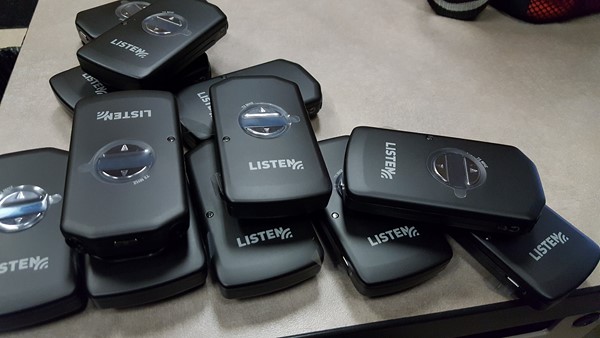You’ll find a hearing assist system in almost any venue nowadays and quality and ease of use vary by style. Hearing assistance in public address systems are a must and it’s important to understand the different types of setups you might encounter.

Hearing assist systems are usually a separate piece of hardware that is separate from the mixer or amplifiers. It can be fed with the same mix as the amplifiers or a completely dedicated mix which can be compressed and EQ’d for optimal clarity. Hearing system mixes should include not only the microphones present in the room but also any computer playback and teleconference audio that migh be used. Let’s review the different types of hearing assist systems currently available.
Receivers – Included with all systems and customized to pickup whatever audio delivery method the venue uses. Devices are usually handed out to users upon request and range in size from a credit card to a necklace or lanyard worn by the individual. Receivers will include a 3.5mm audio jack for any earbuds or dongles for integration with hearing aids.
RF (Radio Frequency) – Same technology as a two-way radio or baby monitor and has been dependable for years. The system uses a small transmitter with antennas to transmit RF signals to receiver devices given to the end users. RF systems are generally the cheapest but systems range in price depending on the features. Some venues transmit multiple channels of RF for different languages or different rooms and this can easily be accomplished. Common frequencies found can be 2.4GHz, 5Ghz, and 72MHz just like wireless microphones and IEM systems.
IR (Infrared) – Same concept as RF only uses IR radiators to flood infrared light into a space for receivers worn by the user. It has better security than RF because the infrared can be contained to one room and cannot leak through walls. Each room in facility will need it’s own IR radiator and cabling which can add to cost.
Induction Loop (T-Coil) – Hearing Loop in the newest technology and uses a magnetic field from the building to transmit audio to a receiver or T-Coil compatible hearing aid. These systems use copper wire installed in the floor much like a heated flooring system and can span an entire venue. For obvious reasons this is usually only done for new construction or remodel and can also be the most expensive. T-Coil ready hearing aids are becoming more popular and users prefer the ability to connect to a system without any additional hardware. Induction technology seems to be the favorite as long as a well calibrated system is in place.
